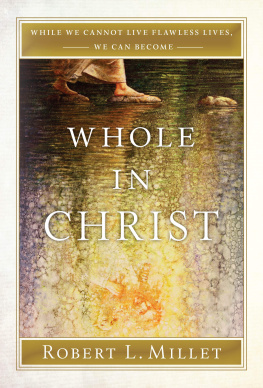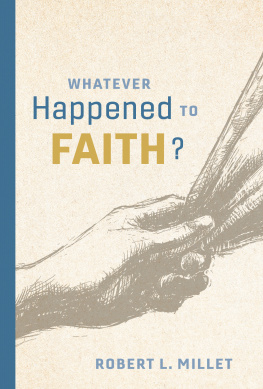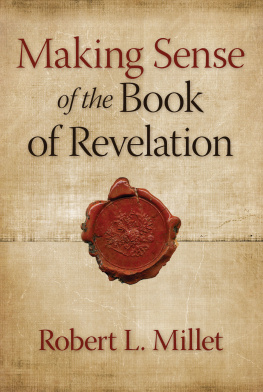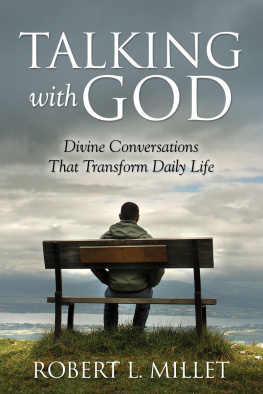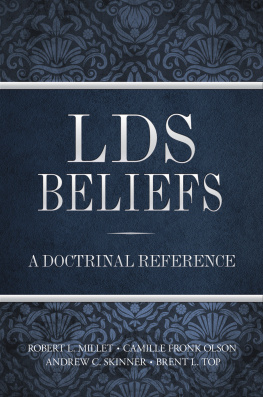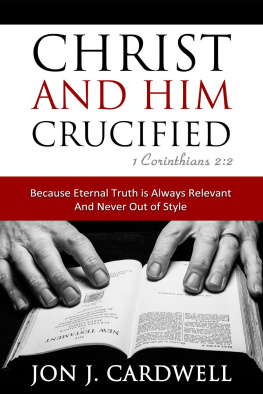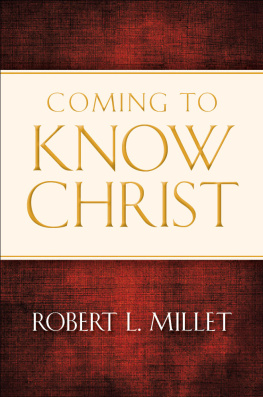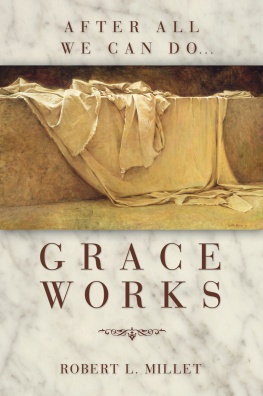2021 Robert L. Millet
All rights reserved. No part of this book may be reproduced in any form or by any means without permission in writing from the publisher, Deseret Book Company, at permissions@deseretbook.com. This work is not an official publication of The Church of Jesus Christ of Latter-day Saints. The views expressed herein are the responsibility of the author and do not necessarily represent the position of the Church or of Deseret Book Company.
Deseret Book is a registered trademark of Deseret Book Company.
Visit us at deseretbook.com
Library of Congress Cataloging-in-Publication Data
(CIP on file)
ISBN: 978-1-62972-945-9 | eISNB 978-1-64933-084-0 (eBook)
Printed in the United States of America
Lake Book Manufacturing Inc., Melrose Park, IL
10 9 8 7 6 5 4 3 2 1
Book design Deseret Book Company
Art direction: Richard Erickson
Design: Sheryl Dickert Smith
Cover art: Faith Yongsung Kim/Havenlight.com
Photo provided by the author
Contents
Preface
S urely there is not a member of the Church of Jesus Christ who does not want to be a better person. That upward reach is a vital part of who we are as children of our Father in Heaven. The Light, or Spirit, of Jesus Christ within each person prompts, enlightens, and leads us toward the good, the right, and the noble (see John 1:9; Moroni 7:13, 16; Doctrine and Covenants 84:4647). The degree to which we become spiritually mature men and women depends on the degree to which we hearken to that moral monitor within our souls.
One of the most significant teachings within The Church of Jesus Christ of Latter-day Saints is that mortals are capable of becoming holy and, in time, of becoming like our beloved Savior (see 1 John 3:13; Moroni 7:48). We learn in the very first book of the Bible that God created humankind in His own image and likeness (Genesis 1:26; compare Moses 2:2627). In referring to this biblical passage, the Prophet Joseph Smith asked: In whose image? In the image of the Gods created they them, male and female, innocent, harmless, and spotless, bearing the same character and the same image as the Gods. Now note what Joseph Smith said next: And when man fell he did not lose his image, but his character still retained the image of his Maker.... Through the atonement of Christ and the resurrection, and obedience to the gospel, we shall again be conformed to the image of his Son [see Romans 8:29]; then we shall have attained to the image, glory, and character of God.
This is a book about becoming bettermuch betterthan we are. It is intended to assist us in facing our daunting task of becoming like our Father in Heaven and His Son, Jesus Christ, both of whom are holy beings. It is about becoming perfect , what that simple but staggering word really means and does not mean, and how the seemingly impossible can come to pass in our individual lives. Matters discussed in this book include how
- we, as followers of Christ, can unhesitatingly and permanently center our lives on the Son of God.
- staying on the gospel path, the covenant path, often requires us to descend, to yield, to surrender, before we can win the ultimate victory through being lifted up by the Savior.
- the depth of our conversion is largely a product of how we interact with Gods childrenin other words, how we love one another.
- the pure love of Christ not only comforts and inspires but also sanctifies the human heart.
- we can, in this life, begin to emulate the Savior and thereby progress from one level of divine grace to a higher level, becoming more and more Christlike in the process.
- the Lord Jesus, through the power of His Holy Spirit, can transform our minds, educate our desires, and develop within each one of us a Christian character, thereby preparing us to dwell comfortably and happily in the presence of pure and holy beings forever.
Acknowledgments
In the preparation of this book, I am indebted to many. I am deeply appreciative, once again, of my friend Von Memory, who was willing to carefully review the manuscript. I express special thanks to Lisa Roper, my product director at Deseret Book, as well as the members of Deseret Books editorial review committee, whose cautions and recommendations have simply made this book stronger. I am also thankful for the keen editorial eye of Alison Palmer, the editor of this book.
Now, having acknowledged others assistance, I add quickly that I alone am responsible for the conclusions drawn from the evidence cited. While I have sought to be in harmony with the writings and teachings of both ancient and latter-day prophets and apostles, this work is a private endeavor and not an official publication of The Church of Jesus Christ of Latter-day Saints.
Notes
. Teachings of Presidents of the Church: Joseph Smith , 52; emphasis added. Cited hereafter as Joseph Smith (manual).
Introduction
The Charge and the Challenge of Perfection
I n His Sermon on the Mount, Jesus Christ closed what we know as chapter 5 of Matthew with the following jolting charge: Be ye therefore perfect, even as your Father which is in heaven is perfect (v. 48). Few divine directives have impacted the mind and heart of those who aspire to Christian discipleship as this one. Few calls of Christ to His followers have yielded more introspection and self-examination. And, sadly, few commands have frightened, discouraged, and inclined more Christians to throw in the towel than this scripture. Seems ironic, doesnt it? The One who loves us infinitely; the One whose work and glory it is to bring to pass our immortality and eternal life (see Moses 1:39); the One who earnestly desires to everlastingly save as many of Gods children as possible (see Doctrine and Covenants 43:25); and the One who beckons to those who labor and are heavy laden to come unto Him and receive rest (see Matthew 11:2830)this same Lord and Savior invites usno, instructs usto become perfect.
When we compare our personal performance with the supreme standard of the Lords expectation, President Russell M. Nelson taught, the reality of imperfection can at times be depressing. My heart goes out to conscientious Saints who, because of their shortcomings, allow feelings of depression to rob them of happiness in life. President Nelson then added: We all need to remember: men are that they might have joynot guilt trips!
Lets reason together for a few moments. In the Old Testament, we read that Noah was a just man and perfect in his generations (Genesis 6:9; compare Moses 8:27). A similar comment is made of Job: he was perfect and upright, and one that feared God, and eschewed evil (Job 1:1). To say that Noah and Job were just men is to say that they were good men, noble and faithful, striving to keep the Lords commandments and doing the best they could, in a proper relationship with God. Now how did Noah or Job arrive at such a holy state? Simply by living in a constant state of repentance, a state that allowed them to gradually become more and more alert and sensitive to the slightest deviation from the covenant path. Noahs and Jobs desires were being educated, and their consciences were becoming fine-tuned. They became just men incrementally, in process of time (Moses 7:21).
President Nelson added that to say these men were perfect does not mean that they never made mistakes or never had need of correction. The process of perfection includes challenges to overcome and steps to repentance that may be very painful. There is a proper place for chastisement in the molding of character, for we know that whom the Lord loveth he chasteneth (Hebrews 12:6; see also Doctrine and Covenants 137:9). Because the word perfect does tend to cause some to doubt whether they can ever make it, ever really become celestial material, I have chosen more often throughout this book to use the word whole .

